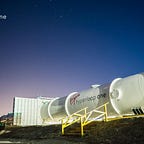From Canals To Hyperloops: The Case For Innovative Infrastructure
The future of our transportation system (and economy at large) depends on bringing those “out there” ideas into the conversation.
By Gibran Hadj-Chikh, Director of Innovative Transport, Parsons Corp.
The year is 1817, and Governor DeWitt Clinton is looking for ideas about how to improve the transportation infrastructure of New York State. On one side of his desk, he has a letter from a group of contractors telling him that they’ve got all the labor and shovels he needs to build roads across the state. On the other side of his desk, he has a proposal from a man named Jesse Hawley to build the Erie Canal. The plan is bold and expensive as all get-out, but it’s something that your average taxpayer can wrap their head around: dig a hole, fill it with water, and connect Albany and New York City to the Great Lakes. It’s ambitious, but he can see how it could work.
While he’s contemplating these ideas, an intern walks in and says, “Pardon me, Governor, but I’ve got these guys in the hall saying they can strap fire to a large piece of metal and make it move faster than a horse. You wanna hear what they’re offering?”
Now, if you were Governor Clinton, trusted with using public funds to bring your constituents the most effective, reliable infrastructure their hard-earned tax dollars could buy, what would you say to those guys in the hall? Ten years down the road, it would turn out that their idea was the way to go, but you have no way of knowing that in 1817 — there is no Department of Transportation to vet the idea, no modeling capabilities to assess the risks and opportunities, and crowdsourcing consists of yelling out an open window and seeing who yells back. So you would probably make the same decision as Governor Clinton — be bold, be ambitious, but stick to ideas you and your constituents can understand.
So here we are, exactly 200 years later, and the United States finds itself in very much the same situation as Governor Clinton: on one side of the desk are a set of practical, much-needed recommendations to fix the infrastructure we have, on the other side of the desk are a list of 50 major infrastructure projects that can really move the needle and break up the bottlenecks in our passenger and freight networks, and out in the hall, we have people saying that they can make the magic box in your pocket summon robots that will take you anywhere in driverless cars, vacuum-sealed tubes, and/or rocket ships. Do you want to hear what they’re offering?
The difference between 1817 and 2017 is that we now understand the concept of enabling technologies, that no one idea can succeed by itself; instead, it must exist within an ecosystem of products and services that will make it convenient to the people tied into that ecosystem. If you look at the major innovators of the 21st century — Apple, Google, Tesla — they have all succeeded because they’ve been able to map individual products to a larger plan for where they want to be: iPhones made it possible to sell songs and apps, Google searches made it easier to find the products you want, and Tesla makes it possible to hear those songs and run those searches off of a car powered by the sun.
Enabling technologies are the difference between science fiction and bankable investments. We’ve been trying to get Americans to share rides with total strangers for decades, but it didn’t happen until we had the mobile applications, the dispatching algorithms, and the feedback loop between customers and transportation providers to make products like Uber work. Autonomous vehicles were unthinkable even five years ago, but advances in navigation systems and machine learning are now making them commercially viable.
And then there’s the Hyperloop — the heir apparent to the monorails and maglevs we’ve been promised for more than 60 years. Those systems have always faced the same first-mile, last-mile problems that conventional rail systems face, so why would a Hyperloop be any better? Because the enabling technologies are already under development:
- Advanced composites to reduce the weight and cost of the structures
- Vehicle-to-infrastructure systems that could allow cars to dock and depart from Hyperloop tubes, allowing a “single seat” ride
- Mobility hubs designed to provide seamless intermodal connections between Hyperloop services, regional transit lines, and rideshare options
Every generation expects its leadership to be good stewards of public funds and to make decisions about critical infrastructure accordingly. The 50 projects being considered as priorities for the current administration are all worthy of federal investment, but with so many enabling technologies on the horizon, we have to find a way to bring those guys from out in the hall into the conversation. Our future depends on it.
Gibran Hadj-Chikh is the Director of Innovative Transport for Parsons Corporation, a member of the Hyperloop One Technical Advisory Board.
